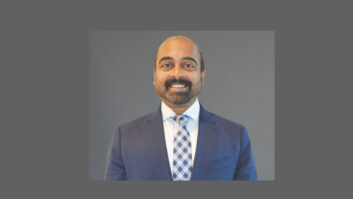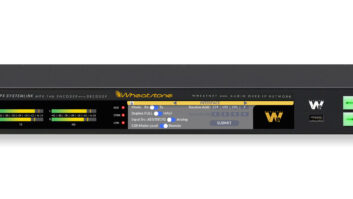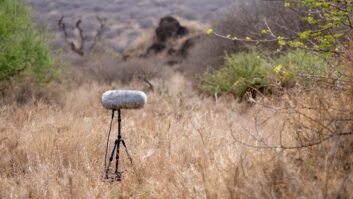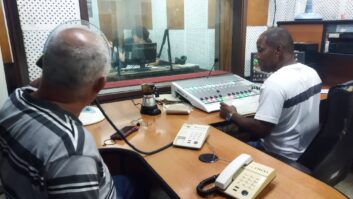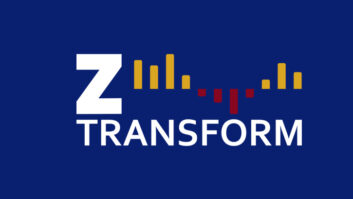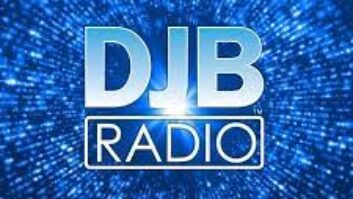It’s been fun reading and sharing reader submissions about how they got started in broadcasting. Keep ’em coming; and if you have high-resolution pictures, old or new, email those as well. Send to [email protected].
Dino Gatsoulas had an interesting start to his broadcast career. He is no stranger to radio. In the ’70s he caught the bug. His father had a Greek show on WKRI in the Providence, R.I., area. Dino would accompany his dad but found himself shadowing the engineer. He loved looking in the backs of the equipment racks, especially watching the belts and gears of the reel-to-reel machines.
When he was around 5 years old, Dino’s dad sat him on a knee to say “Kala christougenna” (“Merry Christmas” in Greek) in the studio. He told Dino to watch the red on-air light, and when it came on, he was to speak. The on-air bug bit when Dino attended church the next day and all these people told him how good he sounded.
Fast-forward to the mid ’80s. Dino and his dad had several Greek programs, culminating in a 24/7 Greek language SCA service. That’s when Dino really got to enjoy modifying things and learning how they work — all while on a budget. Like many broadcast engineers, Dino says he’s mostly self-taught, except for basic electronics in high school.
***
On that theme, Dino also tells us how he repurposed a DJ light controller as a remote start application in a small-budget studio.
As engineers, it’s in our genes to repurpose one piece of gear to solve another problem. Dino has been reading RW since the 1980s. In building his budget voiceover studio, he chose a Behringer DX-2000 DJ mixer because he liked the built-in remote start options. However, Dino needed more, so he repurposed an old DJ light switch panel, which he found in his garage.
He took it apart, and painted it black to match the mixer, leaving only the switches. His Brother P-Touch label maker did the rest.
Dino had one problem: He found that the switches didn’t quite line up to the faders. However, if he flipped the panel upside down, the buttons matched up perfectly with the faders.

Dino replaced the first two switches with DPDT toggle switches that he had on hand. They control the mics. They were black, but he raided his wife’s makeup drawer and “borrowed” some sexy red nail polish. The toggle switches connect to a home-made relay box that mutes the studio speakers while turning on the mics and on-air lights. The finished project is shown in Fig. 1.
As for the remote panel, Dino says you can find these used light switch panels on the internet.
Got a mod or upgrade you put together? Share it with your fellow engineers through Workbench. Your printed submission will also count toward SBE recertification credits.
***
If you are looking look to upgrade a conference room in 2019, you may want to consider the Yamaha YVC-200 portable USB+ Bluetooth speakerphone. The portable conferencing device is designed to provide users with ample, clear sound no matter where they work.
“The workplace has changed greatly since even five years ago, with more and more people meeting remotely, setting up temporarily in huddle spaces, or working wherever is most convenient. This has redefined users’ expectations and conferencing requirements,” said Phil Marechal, Yamaha Unified Communications vice president of business development and product management, in a company marketing piece.
He said the YVC-200 is suitable for employees, business executives, entrepreneurs and anyone else who needs conference-room quality audio without access to a conference room.
The compact speakerphone fits in your palm and combines voice activity detection and adaptive echo cancellation. The voice activity detection focuses on speech rather than background noise and delivers full-duplex conversation without dropouts, even when multiple people are speaking, the company says.
To start a remote meeting, users connect the YVC-200 to their audio, video or web conferencing client. Equipped with both USB and Bluetooth, with pairing to NFC-enabled devices, the YVC-200 can connect to a PC, smartphone or tablet. A built-in rechargeable battery provides up to 10 hours of operation. Plus, the speakerphone is software agnostic.
Contact a Yamaha dealer for more information.
***
Bible Broadcasting’s Steve Tuzeneu sends in a link to some neat audio delay software.
Initially designed to sync up radio sports broadcasts with television, a delay of from 0.1 second to several minutes can be selected. The software was developed by Fountain Computer Software Tools.
Their website is www.fountainware.com. Select their software products from the list on the left. Engineers may also be interested in their free audio spectrum analyzer software or free topo maps. (For spelunkers, there’s a Cave Mapping software tool that’s also interesting.)
***
Consulting Engineer Charles “Buc” Fitch, P.E., wrote a column nearly 10 years ago on controlling your FM antenna deicers.
You’ve probably heard, with respect to social media and questionable choices, that the content of the World Wide Web never goes away. Well, the same can be said for Radio World articles, and what’s even better is that Buc’s tips are just as relevant nearly a decade later.
Buc warns in the title of his piece that February is not the time to see if your deicers are working! Enjoy the last of Indian summer, download the article and if you don’t have deicer controls, consider adding Buc’s suggestions.
You’ll find the article at www.radioworld.com/miscellaneous/dont-wait-for-february-to-check-deicers. Or at RW’s home page, type “Fitch deicers” into the search field.
Your ideas can help your colleagues. Send Workbench tips and high-resolution photos to [email protected]. Fax to (603) 472-4944.
Author John Bisset has spent 48 years in the broadcasting industry and is still learning. He handles Western U.S. radio sales for the Telos Alliance. He is SBE certified and is a past recipient of the SBE’s Educator of the Year Award.







